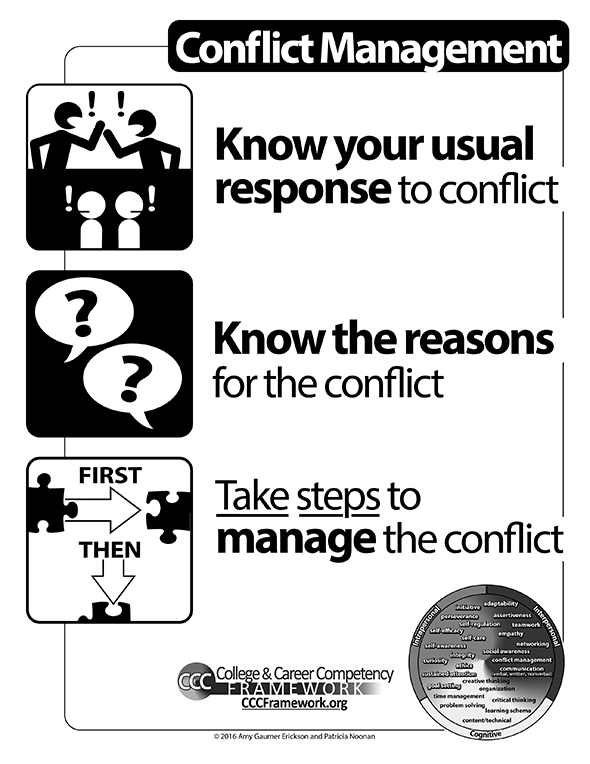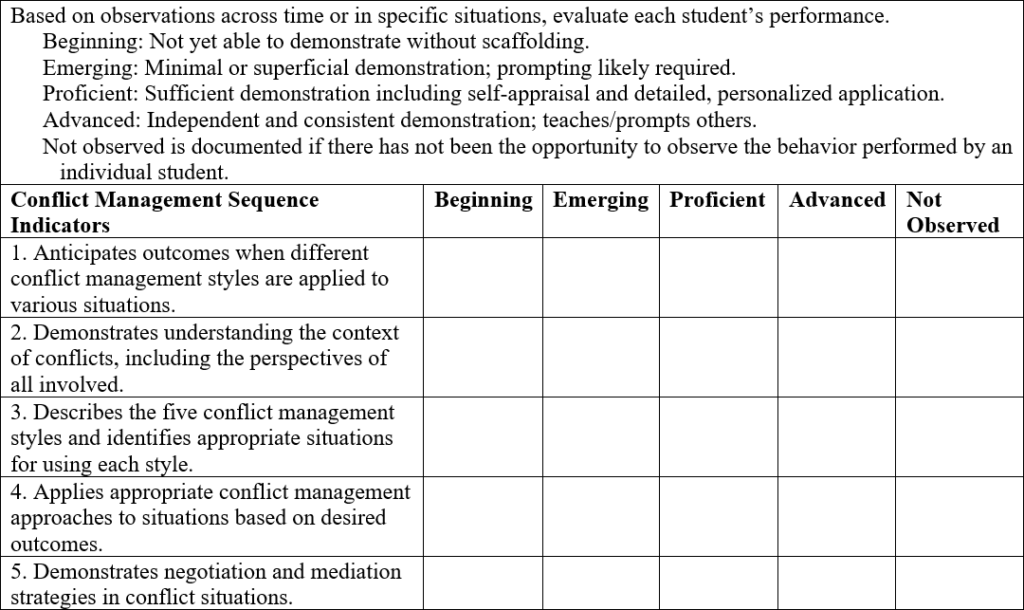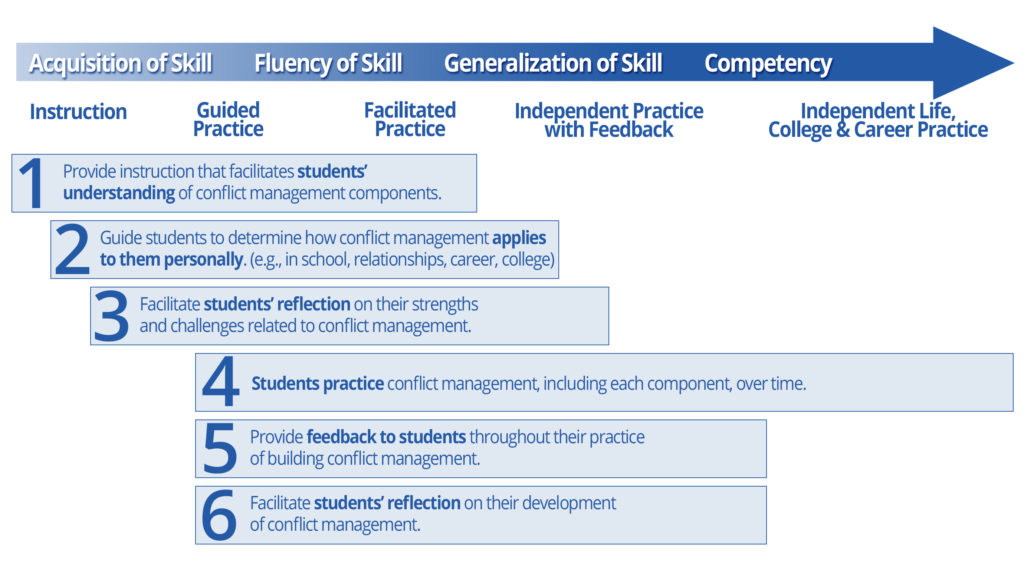Overview
- About This Module
- Why Teach Conflict Management?
- What Is Conflict Management?
- The Conflict Management Performance-Based Observation
- The Six Instructional Criteria
Part 1: Teaching Students What Conflict Management Is and Why It Is Important
Part 2: Understanding Your Ability to Manage Conflicts
Part 3: Understanding Your Usual Response to Conflict
Part 4: Embedding Opportunities for Students to Practice Conflict Management
Part 5: The College and Career Competency Framework
Overview
About This Module
This professional learning module supports educators in understanding how to support students in developing conflict management, an interpersonal competency within the College and Career Competency (CCC) Framework, developed by Drs. Amy Gaumer Erickson and Patricia Noonan.
The Overview describes conflict management and its components, the research and impacts of teaching conflict management, and the need for embedding competency instruction across school contexts. A performance-based observation tool is included to help you assess students’ ability to manage conflict.
Parts 1–3 of this module contain instructional activities that help students understand key concepts and practice managing conflict. Each part includes a learning target with numerous activities that support the learning target. The Reflect and Apply portion will deepen your knowledge of conflict management concepts. Part 4 offers suggestions for embedding conflict management practice opportunities in any classroom. Finally, Part 5 will build your knowledge of the College and Career Competency Framework and provide guidance for adoption and implementation of conflict management instruction schoolwide.
As you review Parts 1–5 of the module, record your ideas, thoughts, and actions in the Educator Workbook. This workbook contains activities, reflective questions, instructional tools, and assessments that we will refer to throughout the module. After completion of the module, submit your Educator Workbook to earn 9 Continuing Education Units (CEUs).
As you explore the activities, consider how you will deliver conflict management instruction to your students. The “Teach Students Handouts” are located on page 11 of the Educator Workbook. Think about how you will deliver the instructional activities, noting any adaptations to meet the needs of your students.
Why Teach Conflict Management?
Teaching conflict management to students:
- brings attention to important issues,
- encourages self-reflection,
- makes relationships stronger,
- improves students’ abilities to work through obstacles while under stress, and
- is most successful when integrated with subjects that already deal with conflict (e.g., literature, history, science).
Adolescents who lack conflict management
- have poor mental wellness and social adjustment,
- are less engaged in school, learn less, and retain less information,
- have worse job performance and higher job turnover, and
- are less able to overcome stressors effectively.
Sources: Crooks, et al., 2015; Johnson & Johnson, 1995; Johnson & Johnson, 2002; Johnson & Johnson, 2004; Katic et al. 2020; Pickens, 2009; Reio & Trudel, 2013; Roberson et al., 2015; Stevahn et al., 1997; Ubinger et al., 2013
Watch this 5-minute overview video, created for educators, which describes conflict management and why we should teach it. As you watch, complete the guided notes page found on page 2 of your Educator Workbook.
When educators provide explicit instruction and practice opportunities in several classrooms, they report that students experience
- increased understanding of their natural response to conflict and the various methods for addressing conflict;
- increased ability to compromise or collaborate with their peers and negotiate solutions;
- improved behavior;
- improved communication;
- healthier, improved, or more meaningful relationships; and
- increased self-reflection/self-awareness (Noonan & Gaumer Erickson, 2019).
What Is Conflict Management?
Conflict management is an interpersonal competency defined as “knowing how you usually respond to conflict, the reasons behind specific conflicts, and taking steps to resolve conflicts” (Noonan & Gaumer Erickson, 2018, p. 131). First, consider the definition. What does “knowing how you usually respond to conflict” mean? What are some examples of how we respond to conflict? What does the phrase “reasons behind specific conflicts” mean? How can we determine these? What does “taking steps to resolve conflicts” mean? How might this look? Why would resolving conflicts benefit our students academically as well as in their lives?
Conflict management has three components (Gaumer Erickson & Noonan, 2015), and all three are important when working through a conflict situation. Students should receive instruction as well as ongoing, embedded opportunities to practice each component to improve their ability to manage conflicts.

The first component is know your usual response(s) to conflict(s). For example, do you withdraw, get in someone’s face, go along even if that’s not what you really think or feel, or try to work things out so everyone is happy? Do you have a typical response to most conflicts (e.g., avoiding the conflict), or do you respond differently to various contexts (e.g., siblings vs. authority figures)? Encourage your students to self-reflect how they usually respond to conflict so they can recognize situations where they already excel in handling conflict and situations where they could alter their approach.
The second component is know the reasons for the conflict. For example, is it a misunderstanding or miscommunication? What’s the history of each party involved? Maybe the conflict is ongoing—what started it? Try to figure out the perspectives of everyone involved—in other words, put yourself in the other person’s shoes. Once you have reflected on each of these questions, you will better understand the context, “the set of circumstances or facts that surround a particular event, situation, or conflict” (Noonan et al., 2017, p. 21), and you will be better prepared to choose an appropriate conflict management style.
The third component is take steps to manage the conflict. Conflict management teaches students that there are various steps they can take when resolving a conflict. For example, they may choose to use the collaborating conflict management style, in which they utilize negotiation or mediation techniques to reach a solution that satisfies everyone. Students may also choose to remove themselves from the situation for a time to pause and reflect on their options or seek advice on how to resolve the situation. Students must understand that the steps they choose to take to resolve the conflict will affect the outcome.
Listen as Dr. Pattie Noonan provides an overview of the three components:
The Conflict Management Performance-Based Observation
How can we determine how well each student manages conflict? The Conflict Management Performance-Based Observation (Gaumer Erickson & Noonan, 2021), found on page 12 of the Technical Guide, assesses how well students demonstrate the skills needed to build conflict management. It is appropriate for students of any age and can show growth over time when combined with explicit instruction and practice. This observation tool can also be used at purposeful intervals to monitor the development of each student. Based on observations across time or in specific situations, the educator rates indicators of conflict management for each student. This assessment can be completed at https://www.cccstudent.org/, which will automatically graph individual student and classroom data. The Technical Guide provides additional information on this assessment.

Reflect and Apply:
Now that you know a little more about conflict management and why it is essential, as well as how to measure it, take a few minutes to reflect and consider the below questions (found in the Educator Workbook on page 3):
- What are your reasons for wanting to teach conflict management?
- What changes do you want to see within your students resulting from teaching conflict management?
The Six Instructional Criteria

These Six Instructional Criteria (Gaumer Erickson et al., 2015) are the steps for instructing students in conflict management. These criteria represent the way we teach any content, such as helping students learn a new math concept or further developing a skill that they need to master. These criteria should be applied when teaching conflict management.
Instructional Criterion 1 is facilitating students’ understanding of the competency. For example, if you were introducing a unit on the Civil War in a social studies class or chemical reactions in a science class, you would start by helping the students understand each of those topics. Similarly, students need to understand what conflict management means. You can help students understand what conflict management is by breaking down the definition and facilitating discussion. When students can accurately define conflict management in their own words, you have facilitated their understanding.
Instructional Criterion 2 is helping students understand how the competency applies to them personally. For example, how will learning conflict management help them improve their relationships with others? Students need to understand and believe that learning conflict management can help them achieve their goals. One way you can assist students in understanding how conflict management applies to them is to explain that learning and practicing it will help them address disagreements independently and that they are less likely to receive disciplinary actions such as office referrals.
Instructional Criterion 3 is helping students identify their strengths and challenges related to conflict management. We all have situations in which managing conflict is challenging. Students are no different. Helping them identify when managing conflict is difficult and teaching them how to apply strategies during those times will increase the likelihood that they begin to generalize it in all areas of their lives.
Instructional Criterion 4 is providing students with opportunities to practice conflict management. Students need ongoing opportunities to practice conflict management, including all three components. Practice opportunities occur during class discussions and interactions with other students. Students can even practice using conflict management during interactions with teachers, siblings, or parents.
Instructional Criterion 5 requires that we provide students with feedback while working on conflict management. As you notice students starting to apply conflict management, offer specific feedback on how they are doing. Provide feedback on the steps they are taking to manage the conflict, and prompt them to consider the perspectives of each person involved in the conflict and anticipate the outcomes of applying each of the five conflict management styles.
Instructional Criterion 6 requires providing students with opportunities to reflect on their development of conflict management. Students can compare how they conduct themselves during a disagreement with before and after learning the styles and strategies. Analyzing the differences in how they approached each conflict will help them determine which areas of conflict management are getting easier and which areas are still challenging for them.
Let’s listen to educators describe how they provided conflict management instruction and the impact on students. Choose an educator reflection video to view.


